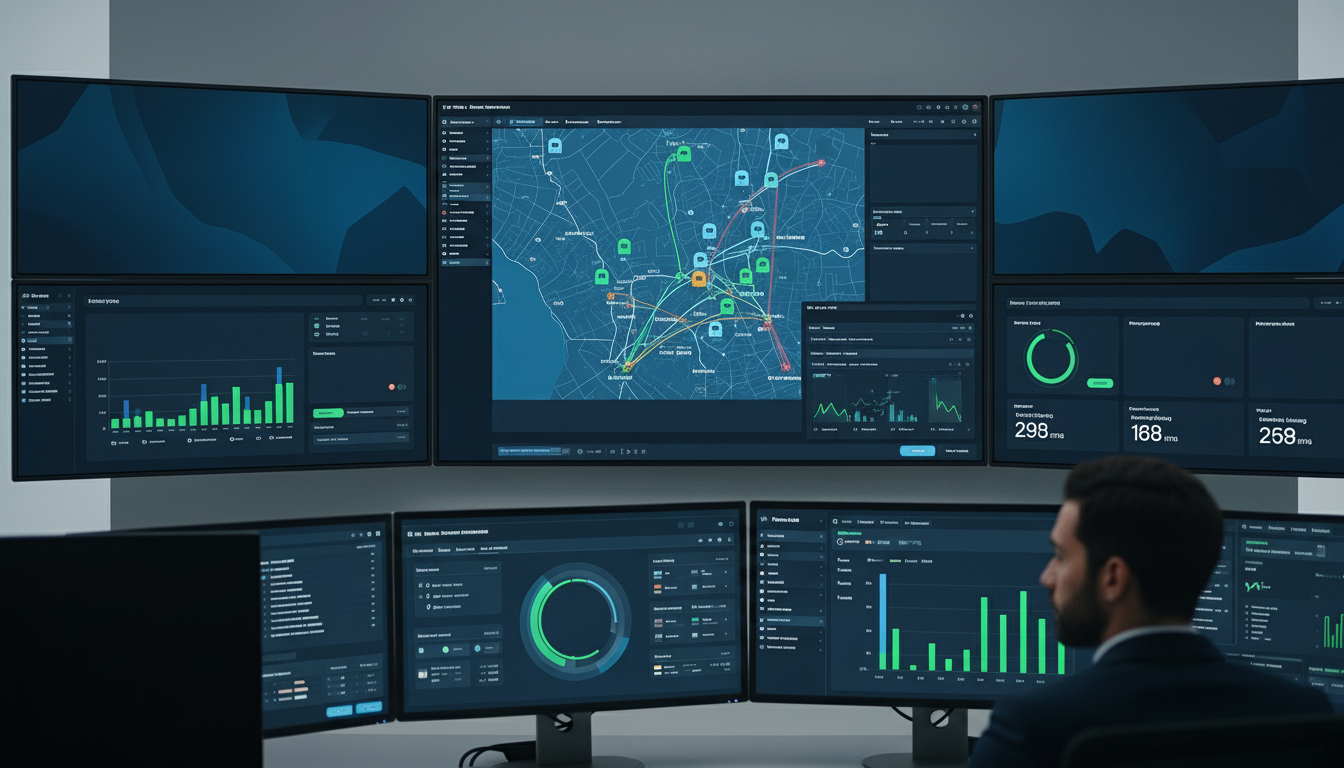Comprendre l'IoT dans la gestion de la flotte
L'Internet des points (IdO) stands for a network of adjoined devices that communicate and share information with each various other. Dans le contexte de la gestion de la flotte, IoT technology integrates various elements like sensing units, Appareils GPS, and software systems to produce an extensive system that monitors, evaluates, and enhances fleet procedures. By leveraging this adjoined network, fleet supervisors can accomplish a greater degree of control and exposure over their vehicles and possessions, significantly improving anti burglary for truck abilities.
Among the foundation technologies in IoT for fleet management is the GPS tracker. Devices such as the Protrack GPS tracker are essential for real-time place monitoring, Optimisation du chemin, and possession management. These trackers continuously send out place information to systems like the Protrack365 GPS system, which after that processes and evaluates this information, providing critical understandings into vehicle efficiency, Habitudes de chauffeur, and overall fleet effectiveness. The integration of these technologies enables smooth information collection and management, offering an extensive view of fleet procedures, and functioning as a dependable anti burglary monitoring device for cars. En plus, specific gps trailer monitoring ensures security for valuable freight.
Presently, IoT fostering in fleet management is steadily enhancing as companies acknowledge its potential benefits. Improved effectiveness is just one of one of the most considerable benefits, as IoT enables fleet supervisors to improve procedures, optimiser les itinéraires, and decrease downtime. Cost decrease is one more critical benefit; with real-time information, Les entreprises peuvent minimiser la consommation de carburant, decrease upkeep costs, and prolong the life expectancy of their vehicles. De plus, IoT adds to improved safety by monitoring chauffeur habits, determining risky patterns, and providing prompt notifies to prevent accidents, while at the same time bolstering anti burglary for truck securities.
As the IoT landscape proceeds to develop, its applications in fleet management are broadening. From anticipating upkeep to automated conformity coverage, IoT is changing the way fleets run. By accepting IoT technologies like the Protrack365 GPS system and Protrack GPS trackers, fleet supervisors can open new degrees of functional effectiveness, économies de coûts, et la sécurité, placing their fleets for long-lasting success in an progressively affordable market, all while providing advanced anti burglary monitoring device for cars performances and secure gps trailer monitoring.
TECHNOLOGIES CLÉS IOT pour la gestion de la flotte
Efficient fleet management is progressively dependent on the integration of specific IoT technologies that provide real-time information and workable understandings. Amongst these technologies, GPS monitoring systems, dispositifs de télématique, et diagnostics à bord (OBD) devices play critical functions in enhancing fleet procedures and improving anti burglary for truck security.
Among the foundation technologies in fleet management is the GPS monitoring system. Systems such as Protrack365 GPS system offer advanced monitoring abilities, enabling fleet supervisors to monitor vehicle locations and movements in real-time. The Protrack GPS tracker not just provides place information but also integrates with various other systems to offer extensive understandings into chauffeur habits, Optimisation du chemin, and fuel effectiveness, functioning as an efficient anti burglary monitoring device for cars and an important gps trailer locator.
Telematics devices are another essential element in fleet management. These devices gather a large array of information factors relates to vehicle efficiency and chauffeur habits. By transmitting information on speed, stopping, vitesse, et consommation de carburant, telematics devices give fleet supervisors the capability to analyze and improve driving methods, réduire les coûts fonctionnels, and improve safety procedures. The integration of telematics information with fleet management software further aids in anticipating upkeep and functional effectiveness, significantly improving anti burglary for truck measures.
Diagnostic à bord (OBD) devices complement the performances of GPS and telematics systems by providing detailed information on vehicle health and wellness. OBD devices can monitor various engine specifications, spot mistakes, and alert fleet supervisors to potential upkeep problems before they become critical. This positive approach to vehicle upkeep ensures minimal downtime and prolongs the life expectancy of fleet possessions, production the fleet much less vulnerable to burglary and a more durable anti burglary monitoring device for cars possession.
The harmony of these IoT technologies is enhanced when incorporated with extensive fleet management software. Such software systems amalgamate information from GPS, télématique, and OBD devices, offering a combined control panel for evaluation and decision-making. This alternative view enables fleet supervisors to create informed choices, optimiser les itinéraires, Gérer la consommation de carburant, and ensure prompt upkeep, eventually improving the effectiveness and efficiency of fleet procedures, together with effective anti burglary for truck and gps trailer security features.
Implémentation de solutions IoT dans votre flotte
Implementing IoT solutions in fleet management starts with a comprehensive evaluation of the specific needs of your fleet. Understanding these requirements is crucial for choosing the right IoT devices and software. Begin by assessing your fleet’s dimension, the kinds of vehicles you run, Et les mesures clés que vous visez à surveiller, comme la consommation de carburant, path effectiveness, et les routines d'entretien, consisting of durable anti burglary for truck solutions.
Once the needs are plainly specified, the next step is choosing the appropriate IoT devices and systems that align with these requirements. Pour les circonstances, the Protrack365 GPS system is an extensive service that offers advanced monitoring abilities, real-time information analytics, and smooth integration with various IoT devices. Choosing a durable system like Protrack365 ensures that you have a dependable structure for your fleet management procedures, consisting of detailed monitoring for gps trailer units.
Le processus d'installation consiste à équiper chaque véhicule avec les appareils IoT sélectionnés, comme le tracker GPS Protrack. These devices should be installed by qualified experts to ensure precision and dependability. Proper installation is critical for catching precise information and avoiding potential problems down the line, and ensuring the effectiveness of the anti burglary monitoring device for cars. Après l'installation, L'intégration du système est la prochaine étape cruciale. This involves connecting the IoT devices to the main system, ensuring that information streams are synchronized and accessible in real-time, providing extensive anti burglary for truck monitoring.
Initial configuration of the system consists of setting up the software according for your fleet’s specific requirements. This might involve establishing geofences, specifying alert specifications, and personalizing dashboards to display one of the most appropriate information. It’s essential to conduct comprehensive testing throughout this stage to determine and correct any problems before complete implementation, ensuring your gps trailer is constantly secure.
Ensuring information precision and dependability is a continuous process. Regularly calibrate and maintain the IoT devices to avoid inconsistencies. Implementing finest methods such as regular audits and information recognition inspects can help maintain information integrity. En outre, educating staff to effectively utilize the new technologies is critical. Extensive educating programs should cover both the functional aspects of the IoT devices and the logical devices provided by the system. This ensures that the group is fully equipped to take advantage of the complete potential of the Protrack365 GPS system, production it an effective anti burglary monitoring device for cars.
Maximiser les avantages de l'IoT pour la gestion de la flotte
In the world of fleet management, the integration of IoT technologies provides vast opportunities to improve functional effectiveness and decrease costs. Leveraging information from the Protrack365 GPS system can significantly add to anticipating upkeep. By constantly monitoring vehicle health and wellness metrics such as engine temperature level, oil degrees, and tire stress, fleet supervisors can preemptively address problems before they intensify into expensive repairs or break downs. This positive approach ensures that the fleet remains in ideal problem, reducing downtime and extending the life expectancy of the vehicles, while also improving anti burglary for truck measures.
Path optimization is one more critical location
where IoT can make a considerable impact. Utilizing information from Protrack GPS trackers, fleet supervisors can analyze traffic patterns, problèmes de route, et les emplacements des véhicules en temps réel. This information enables the vibrant modification of routes to avoid blockage, decrease travel time, and improve fuel effectiveness. Improved path planning not just improves delivery times but also adds to lower functional costs and enhanced client satisfaction, sustaining the role of each anti burglary monitoring device for cars.
Monitoring chauffeur habits is essential for preserving a risk-free and efficient fleet. IoT sensing units and GPS trackers provide valuable understandings into driving patterns, such as speeding up, arrêt sévère, et ralenti. En évaluant ces informations, fleet supervisors can determine locations for improvement and implement targeted educating programs to advertise safer driving practices. This not just decreases the risk of accidents but also adds to better fuel economic climate and lower upkeep costs, and enhances anti burglary for truck strategies.
Instances of effective IoT applications in fleet management are plentiful. Companies that have adopted the Protrack365 GPS system record considerable improvements in functional effectiveness and cost savings. Pour les circonstances, a logistics company using IoT for path optimization saw a 20% decrease in fuel consumption, while another firm utilizing anticipating upkeep skilled a 25% diminution des temps d'arrêt des véhicules. These companies also take advantage of superior gps trailer monitoring.
Regarder à l'avance, L'avenir de l'IoT dans la gestion de la flotte est prometteur. Arising trends such as advanced analytics, artificial intelligence, and self-governing vehicles are readied to transform the industry. To stay in advance of the contour, fleet supervisors must continuously develop and update their IoT systems, ensuring they take advantage of the newest technologies to maintain an one-upmanship, thereby improving anti burglary monitoring device for cars and anti burglary for truck solutions.




